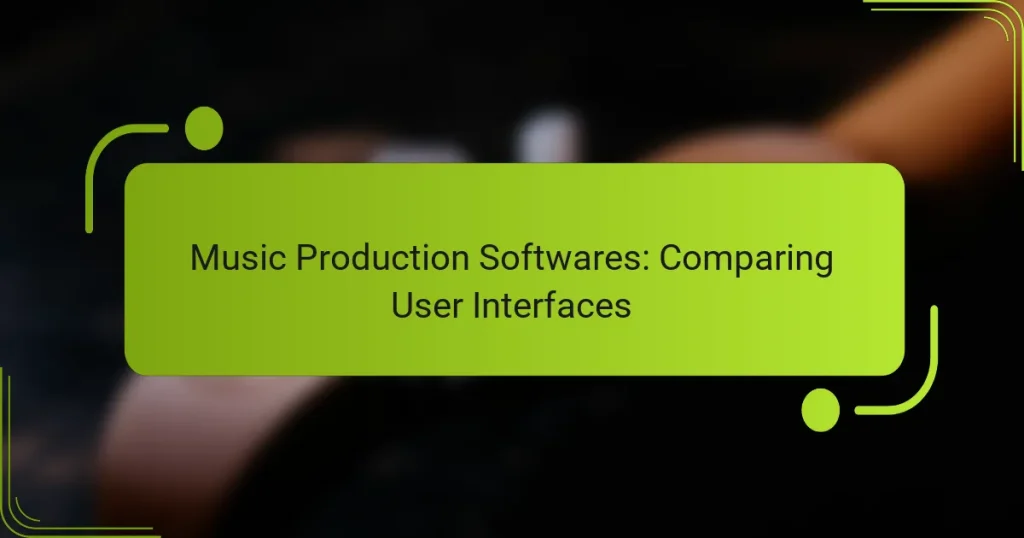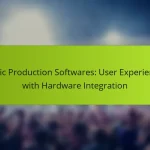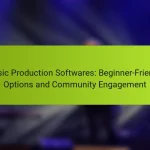In the realm of music production, the user interface (UI) of software can significantly impact a producer’s workflow and creativity. Programs like Ableton Live and FL Studio are often highlighted for their intuitive designs, catering to both novices and seasoned professionals. By examining features such as track management, plugin support, and customization options, users can find the software that best aligns with their unique production style.
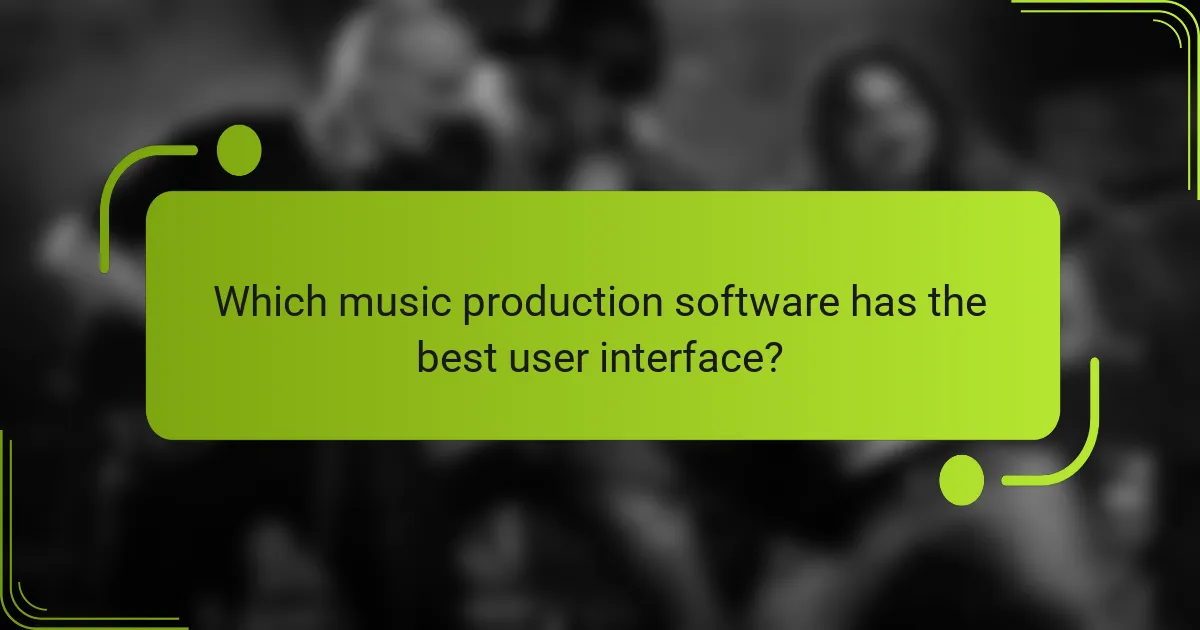
Which music production software has the best user interface?
The best user interface in music production software often depends on personal preference and workflow needs. However, software like Ableton Live and FL Studio are frequently praised for their intuitive designs and ease of use, making them popular choices among both beginners and professionals.
Ableton Live
Ableton Live is renowned for its streamlined and flexible user interface, which supports both live performance and studio production. Its Session View allows users to experiment with musical ideas quickly, while the Arrangement View provides a traditional timeline for detailed editing.
Users appreciate the drag-and-drop functionality and customizable layouts, which enhance workflow efficiency. The software’s clear visual feedback on audio and MIDI tracks helps users stay organized during complex projects.
FL Studio
FL Studio features a visually appealing and user-friendly interface that caters to electronic music producers. Its pattern-based workflow allows for easy creation and arrangement of musical loops, making it accessible for beginners.
The software includes a variety of built-in plugins and effects, all easily accessible through its mixer and channel rack. Users often highlight the ease of navigating between different sections, which contributes to a smooth production experience.
Logic Pro X
Logic Pro X offers a professional-grade interface that balances complexity with usability. Its clean design and logical layout make it suitable for both novice and experienced users, particularly in the Apple ecosystem.
The software provides a comprehensive set of tools for recording, editing, and mixing, all integrated seamlessly. Users can take advantage of Smart Controls and the Mixer view to manage their projects efficiently, enhancing productivity.
Pro Tools
Pro Tools is the industry standard for audio editing and mixing, featuring a powerful interface designed for professional use. Its layout may appear daunting to newcomers, but it offers extensive capabilities for detailed audio manipulation.
Key features include advanced editing tools and a robust mixing console. Users should familiarize themselves with keyboard shortcuts and customizable workspace layouts to maximize efficiency in this sophisticated environment.
Studio One
Studio One combines a modern interface with a straightforward workflow, making it appealing to both beginners and seasoned producers. Its single-window workspace allows users to access all tools without switching between multiple screens.
The drag-and-drop functionality extends to audio, MIDI, and effects, simplifying the production process. Users often find the integrated mastering suite particularly useful for finalizing tracks directly within the software.
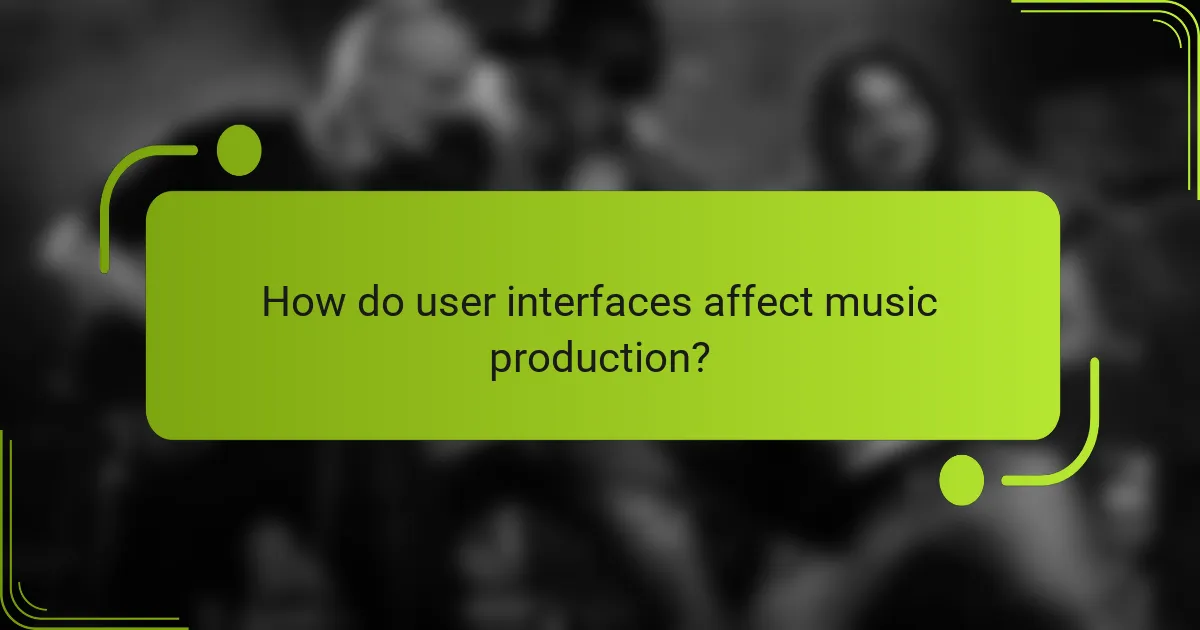
How do user interfaces affect music production?
User interfaces (UIs) play a crucial role in music production by influencing how easily and effectively producers can navigate software. A well-designed UI can streamline workflows, enhance creativity, and reduce the learning curve, ultimately leading to a more productive music-making experience.
Workflow efficiency
Workflow efficiency in music production is significantly impacted by the user interface. A clean, intuitive layout allows producers to access tools and features quickly, reducing time spent searching for functions. For example, software that organizes effects and instruments into easily navigable categories can save valuable minutes during a session.
Consider using digital audio workstations (DAWs) that offer customizable layouts. This flexibility enables users to arrange their workspace according to personal preferences, further enhancing efficiency. Avoid cluttered interfaces that overwhelm with unnecessary options, as they can slow down the creative process.
Creativity enhancement
A user-friendly interface can enhance creativity by providing seamless access to creative tools and features. When producers can quickly experiment with sounds and effects, they are more likely to explore new ideas and push their musical boundaries. For instance, DAWs with drag-and-drop functionality allow for rapid manipulation of audio clips, fostering spontaneous creativity.
Additionally, some software includes visual aids like waveforms and MIDI piano rolls, which can inspire new compositions. Look for interfaces that encourage experimentation without being overly complex, as this balance can lead to innovative music production.
Learning curve
The learning curve associated with music production software is heavily influenced by its user interface. A straightforward UI can make it easier for beginners to grasp essential concepts and tools, while a complicated interface may deter new users. For example, DAWs that offer guided tutorials or tooltips can help users learn effectively without feeling overwhelmed.
When choosing music production software, consider options that provide a balance between advanced features and user-friendliness. Avoid software that lacks adequate documentation or support, as this can lead to frustration and hinder the learning process. A supportive community or active forums can also be beneficial for users navigating their learning journey.
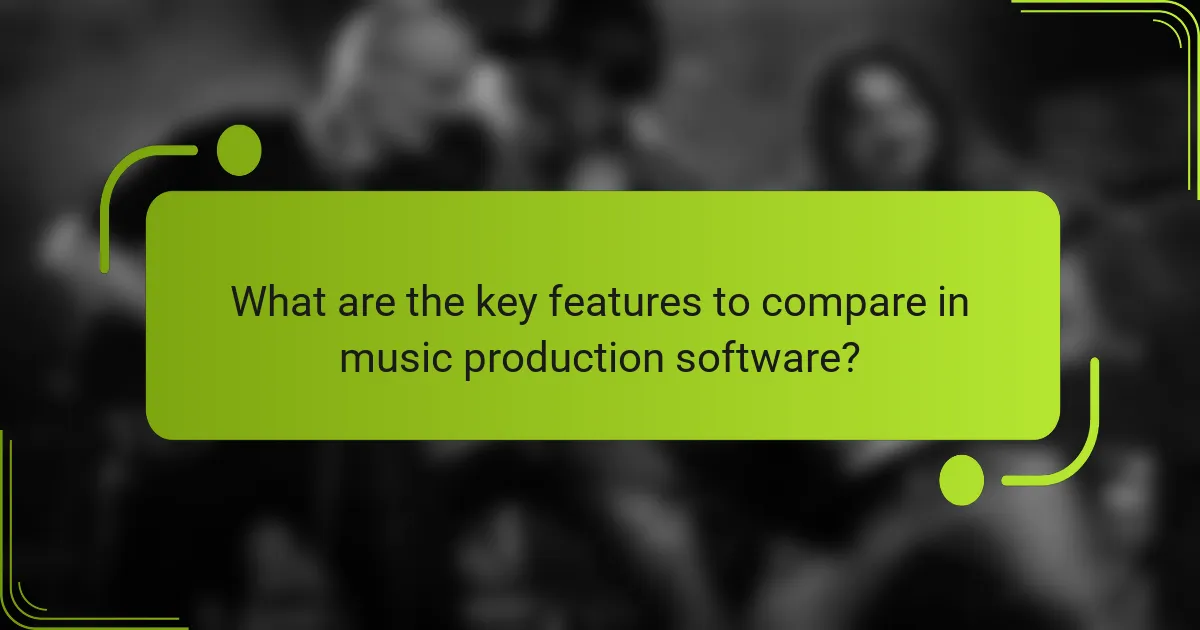
What are the key features to compare in music production software?
When comparing music production software, focus on features that impact workflow and creativity. Key aspects include track management, plugin support, customization options, and visual layout, all of which influence how effectively you can produce music.
Track management
Track management refers to how the software organizes and handles audio and MIDI tracks. Effective track management allows for easy navigation, grouping, and editing of multiple tracks, which is essential for complex projects. Look for features like track folders, color coding, and the ability to quickly mute or solo tracks.
Consider whether the software supports unlimited tracks or has a cap, as this can impact larger projects. Some programs offer advanced features like automation lanes and track freezing, which can enhance your workflow.
Plugin support
Plugin support is crucial for expanding the capabilities of your music production software. Check if the software supports popular formats like VST, AU, or AAX, as this will determine the range of third-party effects and instruments you can use. A wider selection of plugins can enhance your sound design and mixing options.
Additionally, consider the ease of installing and managing plugins within the software. Some DAWs offer built-in plugin managers, while others may require manual installation, which can affect your workflow efficiency.
Customization options
Customization options allow users to tailor the software interface and functionality to their preferences. Look for features that enable you to rearrange toolbars, create custom shortcuts, and save workspace layouts. This can significantly speed up your workflow by allowing you to access frequently used tools quickly.
Some software also offers scripting or macro capabilities, enabling advanced users to automate repetitive tasks. However, be cautious of overly complex customization that may lead to confusion or a steep learning curve.
Visual layout
The visual layout of music production software affects usability and comfort during long sessions. A clean, intuitive interface can help you focus on creativity rather than navigating complex menus. Look for software that offers a clear arrangement of tools and a logical flow for accessing features.
Consider the color scheme and overall design, as these can impact your mood and productivity. Some DAWs allow for themes or skins, which can enhance your experience by making the environment more visually appealing and less straining on the eyes.

How do user interfaces differ across music production software?
User interfaces in music production software vary significantly in design, functionality, and user experience. These differences can greatly influence workflow efficiency and the overall creative process for producers.
Visual design styles
The visual design of music production software can range from minimalist to highly detailed interfaces. Some programs, like Ableton Live, favor a clean, grid-based layout that emphasizes ease of use, while others, such as FL Studio, offer a more vibrant and complex aesthetic with numerous colors and graphical elements.
When choosing software, consider how the visual design aligns with your personal preferences and workflow. A cluttered interface may overwhelm beginners, whereas a straightforward design can enhance focus and productivity.
Navigation ease
Navigation ease is crucial for efficient music production. Software like Logic Pro X provides intuitive menus and shortcuts that streamline access to tools, while others may require more clicks to reach essential features. A well-structured layout allows users to quickly locate effects, instruments, and settings.
To improve navigation, familiarize yourself with keyboard shortcuts and customizable toolbars. This can significantly reduce the time spent searching for features, allowing for a more fluid creative process.
Feature accessibility
Feature accessibility refers to how easily users can access and utilize the tools within the software. Some platforms, such as Pro Tools, are designed for professional use and may have a steeper learning curve due to their extensive features. In contrast, software like GarageBand is more beginner-friendly, offering a simplified set of tools that are easy to understand.
When evaluating software, consider your skill level and the complexity of the features you need. Beginners might benefit from software with guided tutorials and a straightforward interface, while advanced users may prefer more robust options that offer deeper functionality.

What are the top-rated music production software options in 2023?
In 2023, the leading music production software options include Ableton Live 11, FL Studio 20, and Logic Pro X 10.7. Each of these platforms offers unique features and user interfaces that cater to different production styles and preferences.
Ableton Live 11
Ableton Live 11 is renowned for its intuitive session view, which allows users to experiment with musical ideas in a non-linear fashion. This makes it particularly popular among electronic music producers and live performers.
When using Ableton, consider its extensive library of sounds and effects, as well as its powerful MIDI capabilities. The software supports various hardware controllers, enhancing the live performance experience. Beginners should explore the built-in tutorials to quickly familiarize themselves with its features.
FL Studio 20
FL Studio 20 is favored for its user-friendly interface and robust piano roll, making it easy to create complex melodies and rhythms. Its pattern-based workflow allows for efficient arrangement and composition, appealing to both novices and seasoned producers.
Key features include a wide selection of plugins and virtual instruments, which can significantly enhance your productions. Users should take advantage of the trial version to explore its capabilities before committing to a purchase. Keep in mind that while it’s versatile, some users may find the learning curve steep initially.
Logic Pro X 10.7
Logic Pro X 10.7 is a comprehensive digital audio workstation designed specifically for macOS users. It offers a professional-grade interface with advanced features like Flex Time and Flex Pitch, which allow for precise audio manipulation.
This software is well-suited for those who prioritize high-quality audio production and extensive editing capabilities. Logic Pro X includes a vast library of loops and samples, making it easier to create polished tracks. New users should explore the Apple support resources to maximize their experience with the software.
